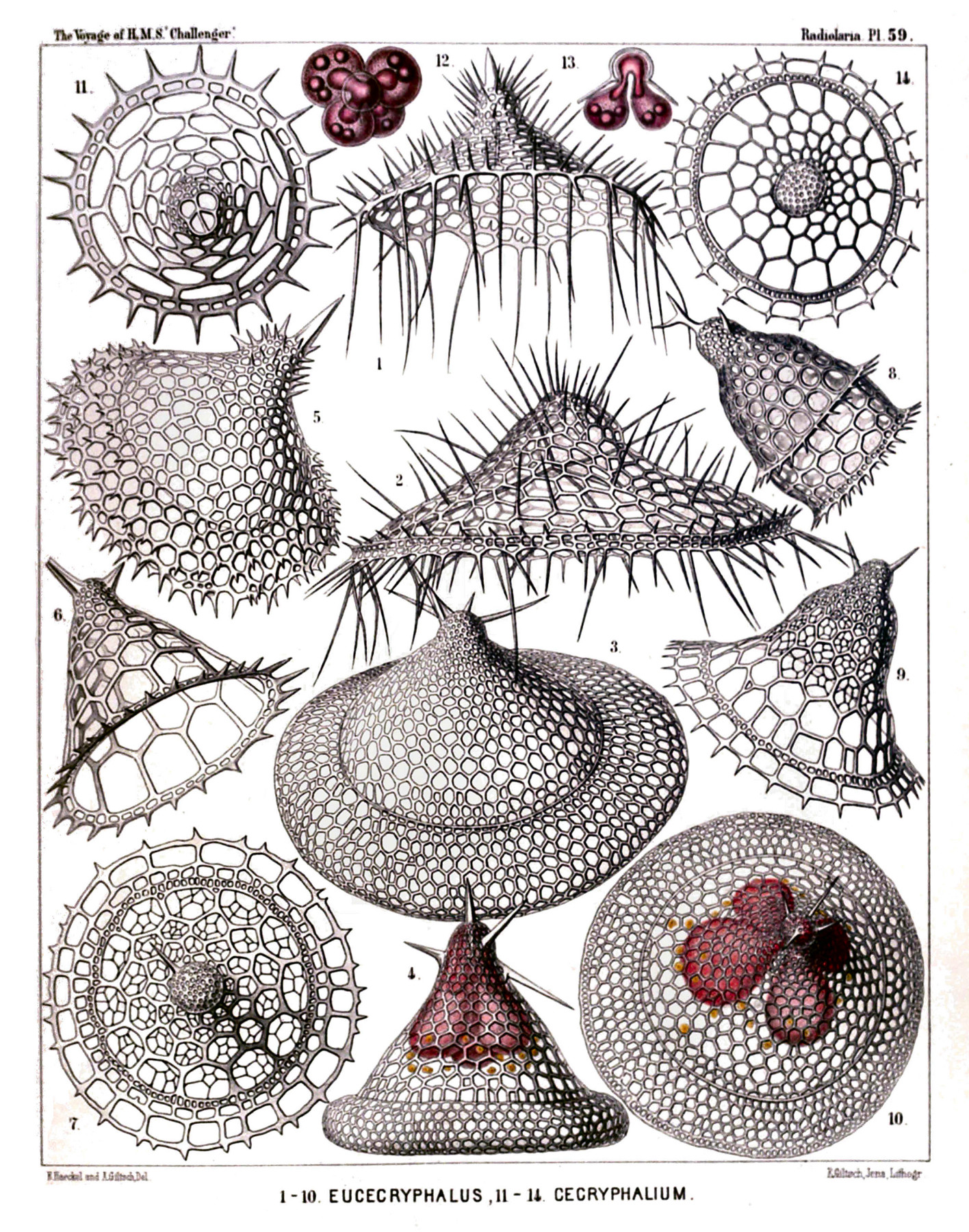
Radiolaria on plate 59 from Ernst Haeckel’s report about the H.M.S. Challenger expedition, 1887.
Radiolarians are unicellular microorganisms constituted by a soft, amoeba-like body with an often elaborate siliceous skeleton resembling a shell, called test. As heterotrophs, they primarily feed on other microscopic organisms drifting around them; but most radiolarians have photosynthetic endosymbionts – microscopic organisms embedded in the radiolarian organism who transform light into energy that the radiolarian can then use. Once the cell dies, their hard siliceous tests sink to the bottom, covering the ocean floor with a siliceous ooze. Thanks to their structure and composition, these remains can survive and become fossilised, as they get trapped in sediments and geological strata. Because of this process, the microfossils of radiolarian tests can be found in various types of geological formations and can provide an important and often readily accessible fossil record. In fact, to this day a vast majority of radiolarian studies focus on the  micropaleontological formations of these organisms – also because, as oceanic life forms entangled in symbiotic relations and with a complex reproductive stage, radiolarians have proven difficult to culture in the lab.
micropaleontological formations of these organisms – also because, as oceanic life forms entangled in symbiotic relations and with a complex reproductive stage, radiolarians have proven difficult to culture in the lab.
In addition, their tests, with their complex, delicate, and geometrical translucent structures, have captured not only scientists’ interest, but also the imagination of artists, architects, and mathematicians. Tracing the transformations of their geometries in the fossil record, radiolarians have been one of the first microbial groups to be organised in a natural system that attempted to see evolutionary change in their diversity of forms by German naturalist Ernst Haeckel.
Because of their small size, resistance, and abundance, as well as their variety, radiolarian tests have been used extensively, in particular after the 1950s, to study geology and oceanography: their impressive fossil record (reaching back to the Cambrian, 500 million years ago) makes them important diagnostic fossils. As such they are used in  biostratigraphy, to date geological samples. Some species, in particular, can provide important
biostratigraphy, to date geological samples. Some species, in particular, can provide important  environmental data, and are used in planetary sciences as proxies and
environmental data, and are used in planetary sciences as proxies and  markers of ancient climates, like in the case of
markers of ancient climates, like in the case of  Cycladophora davisiana. Furthermore, thanks to their small size, they can be extracted and analyzed from the cutting of a
Cycladophora davisiana. Furthermore, thanks to their small size, they can be extracted and analyzed from the cutting of a  geological drill, making them easy to use, cheap, and efficient. For these reasons they are not only central in paleoclimatology and paleo-oceanography, but also in
geological drill, making them easy to use, cheap, and efficient. For these reasons they are not only central in paleoclimatology and paleo-oceanography, but also in  applied geological sciences, being used, for example, in prospecting for
applied geological sciences, being used, for example, in prospecting for  fossil fuels and the
fossil fuels and the  extractive industry writ large.
extractive industry writ large.